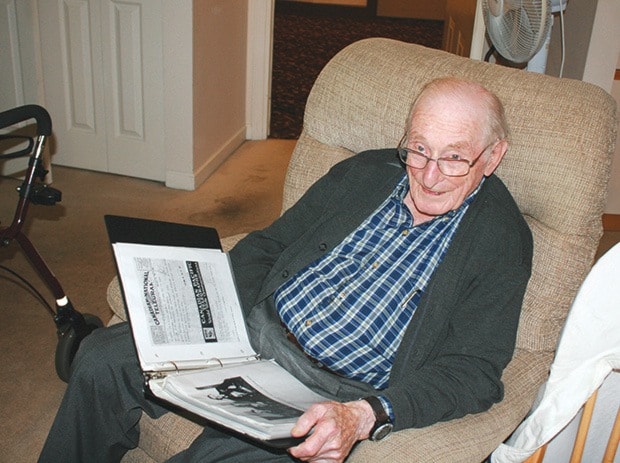Mementos of his time trapped behind enemy lines still line the walls of Harvey Firestone’s home at The Kensington in Saanich.
“We were the only crew in the Second World War to be shot down [behind enemy lines] and get back [to England] while the war was still on,” said Firestone.
Firestone, now 93, was a warrant officer manning the wireless and radar operations on a Wellington bomber. On Sept. 26, 1944 the plane was on a routine anti-submarine patrol over the North Sea when it ran into engine problems. To reduce weight it was decided that they would dump some of their fuel.
“The dump valve stuck and the ended up dumping more fuel than they were hoping for,” said Firestone’s son Rick. “Instead of being able to return to Scotland they ended up having to go the other direction, east.”
The plane crash landed in Norway and the crew of six Canadians fortunately escaped any serious injury. But they weren’t out of harm’s way just yet. The plane had been spotted by the enemy and 4,000 German soldiers were dispatched to seal off the area and locate the crew.
The Canadian crew was able to make contact with a woman who led them to a cave in the nearby hillsides.
“Within a very short time after we had left the crash scene the Germans rounded up all the citizens in the Os area and terrorized them with brutal beatings and torture during the interrogations that followed. Many were sent off to prison, never to return,” Firestone recounted in his story Six Sacks of Potatoes, which is what the Norwegians referred to the Canadian crew as in case their messages were intercepted by the Germans
The crew eventually came in contact with members of the Norwegian resistance who would help them escape from the area. Under the cover of darkness, the crew made their way down the hills and to the shoreline where two rowboats had been stationed. Concealed by the mist and with the oarlocks muffled by rags to prevent any noise, the rowboats drifted past several German patrol boats.
The group pulled ashore on the island of Stono, where they spent a few days hiding in a loft about a boat house.
On Oct. 1 the crew was led to a motorboat, with five of them forced to lay in the hold which normally held the catch of fish. The Canadians were transported across the fjord to a place called Hatvik. The group would eventually make their way up a steep mountainside to a small cabin. The cabin became known as ‘Little Canada’. To this day, the Canadian flag is on display in the window, and locals still refer to the cabin by that name.
A week after arriving at ‘Little Canada’ the crew began to make their way down the mountainside. The group headed back out to sea in a fishing boat, passing several German submarines and naval vessels along the way. The crew landed on a small islet called Ospoy where they waited for the boat that would take them to Britain. On Oct. 12, the crew headed west toward the Shetland Islands and safety.
